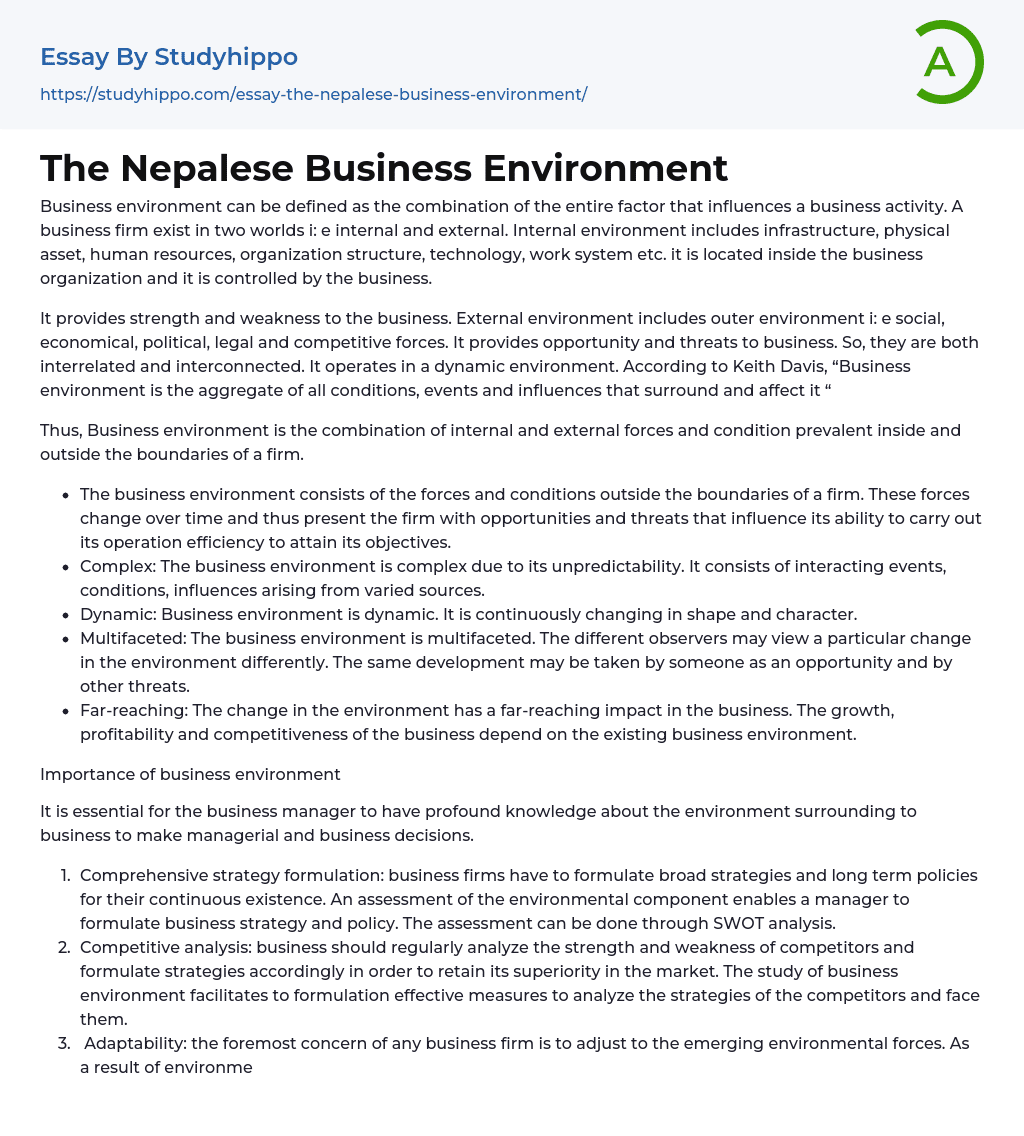Business environment can be defined as the combination of the entire factor that influences a business activity. A business firm exist in two worlds i: e internal and external. Internal environment includes infrastructure, physical asset, human resources, organization structure, technology, work system etc. it is located inside the business organization and it is controlled by the business.
It provides strength and weakness to the business. External environment includes outer environment i: e social, economical, political, legal and competitive forces. It provides opportunity and threats to business. So, they are both interrelated and interconnected. It operates in a dynamic environment. According to Keith Davis, “Business environment is the aggregate of all conditions, events and influences that surround and affect it “
Thus, Business environment is the combination of internal and external forces and condition prevalent inside and outside the boundaries of a firm.
...- The business environment consists of the forces and conditions outside the boundaries of a firm. These forces change over time and thus present the firm with opportunities and threats that influence its ability to carry out its operation efficiency to attain its objectives.
- Complex: The business environment is complex due to its unpredictability. It consists of interacting events, conditions, influences arising from varied sources.
- Dynamic: Business environment is dynamic. It is continuously changing in shape and character.
- Multifaceted: The business environment is multifaceted. The different observers may view a particular change in the environment differently. The same development may be taken by someone as an opportunity and by other threats.
- Far-reaching: The change in the environment has a far-reaching impact in the business. The growth, profitability and competitiveness of the business depend on the existing
business environment.
Importance of business environment
It is essential for the business manager to have profound knowledge about the environment surrounding to business to make managerial and business decisions.
- Comprehensive strategy formulation: business firms have to formulate broad strategies and long term policies for their continuous existence. An assessment of the environmental component enables a manager to formulate business strategy and policy. The assessment can be done through SWOT analysis.
- Competitive analysis: business should regularly analyze the strength and weakness of competitors and formulate strategies accordingly in order to retain its superiority in the market. The study of business environment facilitates to formulation effective measures to analyze the strategies of the competitors and face them.
- Adaptability: the foremost concern of any business firm is to adjust to the emerging environmental forces. As a result of environmental analysis, the managers are able to adopt the prevailing condition and thus to adopt the prevailing condition and thus influence the environment in order to make it congenial or less harmful to their business.
- Stability: the study of the environment enables the firms to foresee the impact of the socio-economic and political changes taking place at the national and international levels on their stability. They can develop actions plan to cope with such change to maintain stability.
- Dynamism: the firm should change and mold itself with the changing environment. The knowledge of business environment enables the manager to be well acquainted with the changing business scenario and take proper steps to keep the firm up-to-date.
Component of the business environment
Internal environment:
The internal environment also called micro environment consist of condition and forces within the business organization that affects its performance and outcomes.
- Atmosphere essays
- Biodiversity essays
- Coral Reef essays
- Desert essays
- Earth essays
- Ecosystem essays
- Forest essays
- Lake essays
- Natural Environment essays
- Ocean essays
- Oxygen essays
- Rainbow essays
- Sea essays
- Soil essays
- Volcano essays
- Water essays
- Wind essays
- Business Analysis essays
- Business Plan essays
- Community Development essays
- Competition essays
- Effective Leadership essays
- Leadership Styles essays
- Mission Statement essays
- Negotiation essays
- Outsourcing essays
- Planning essays
- Public relations essays
- Reasoning essays
- Strategic Management essays
- Strategic Planning essays
- Swot Analysis essays




